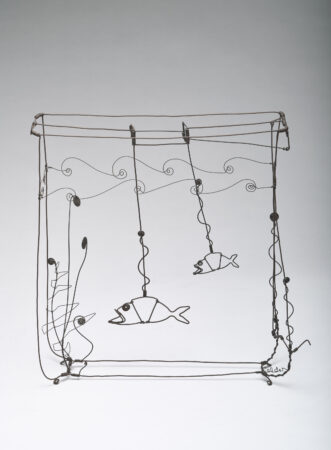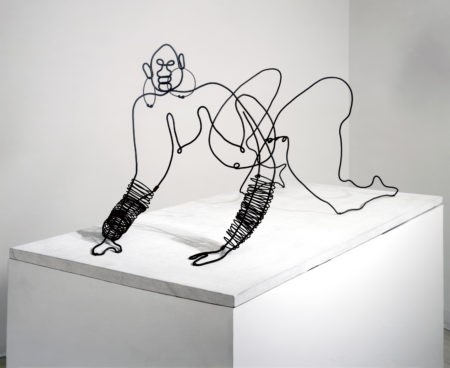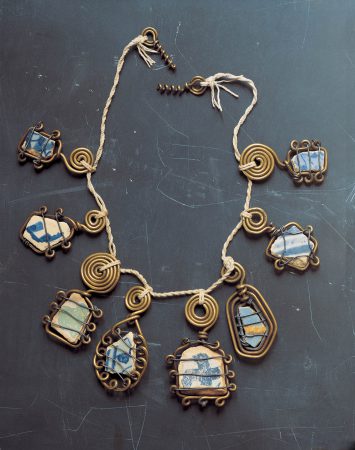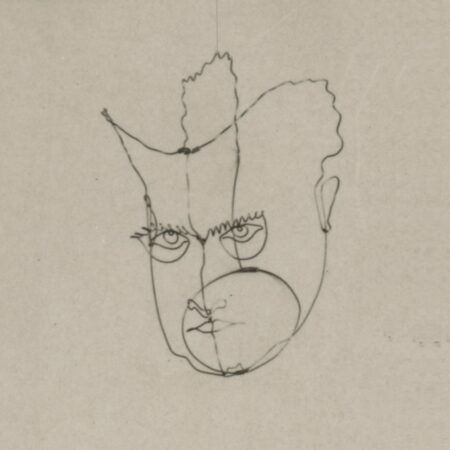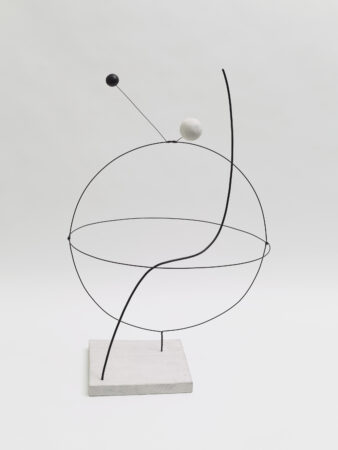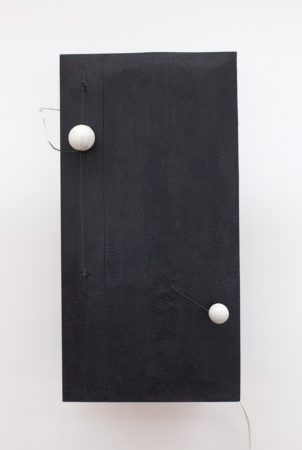Archive
Calder travels back to Berlin to prepare his exhibition.
CF, Calder to parents, 6 AprilGalerie Neumann-Nierendorf, Berlin, presents “Alexander Calder: Skulpturen aus Holz und aus Draht.” Chantal Quenneville Hallis a French paintrix was there and I made a wire fly dangling from a beam attached to a collar. That was about my first jewelry.
Calder 1966, 98–99; CF, Calder 1955–56, 50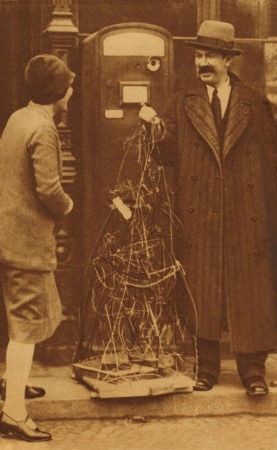
In Berlin, Dr. Hans Cürlis directs a short film of Calder creating Two Acrobats as part of the series Artists at Work. Calder makes a wire portrait of Cürlis.
CF, Calder to parents, before 8 MayI have had 2 large circus parties since coming back to Paris. At one of them we had Paul Fratellini, one of the famous clowns at the Cirque d’Hiver. It was quite a swell party—and I am making one of the toys in a size large enough for him to use in the Cirque d’Hiver.
CF, Calder to parents, before 8 MayCalder exhibits a wire sculpture at the Salon des Tuileries, Paris.
CF, exhibition filePathé Cinema, Paris, produces a short film of Calder at work in his rue Cels studio. Calder invites Kiki de Montparnasse to model for a wire portrait during the filming.
Calder 1966, 99; New York Herald [Paris edition], 21 May; HRC, Calder to Roché, 10 May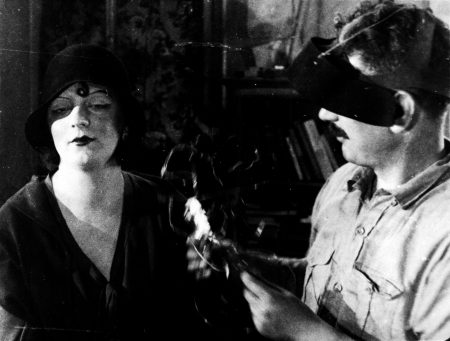
André Kertész photographs Calder at his rue Cels studio.
CF, photography file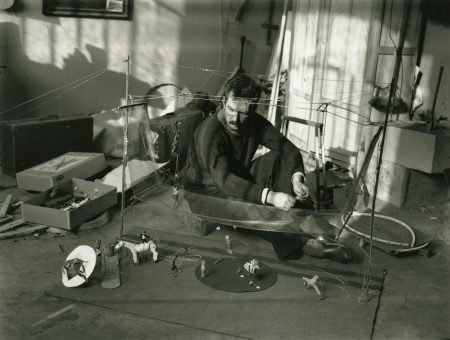
Calder performs Cirque Calder in the studio of Tsuguharu Foujita, a painter and well-known denizen of Montparnasse. Foujita plays a drum to accompany Calder’s performance. Man Ray and Kiki are among the guests in attendance.
HRC, Calder to Roché; Illustrirte Zeitung, 29 AugustCalder embarks for New York on the De Grasse, bringing Cirque Calder with him. During the voyage, he meets Edward Holton James and his daughter Louisa. So once on board the De Grasse, I started walking the deck. I overtook an elderly man and a young lady. I could only see them
from the back, so I reversed my steps the better to see them face on. Upon coming abreast of them the next time around, I said, “Good evening!” And the man said to his daughter, “There is one of them already!” He was Edward Holton James, my future father-in-law. She was Louisa. Her father had just taken her to Europe to mix with the young intellectual elite. All she met were concierges, doormen, cab drivers—and finally me.
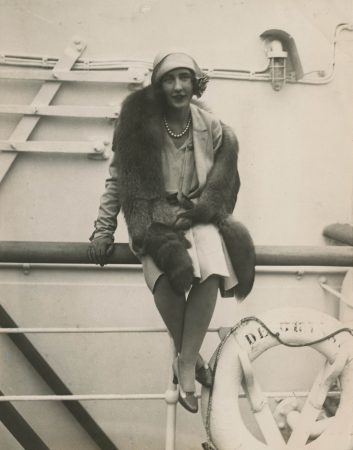
Calder occupies his father’s studio on 11 East Fourteenth Street. He visits his family in Pittsfield, Massachusetts.
Calder 1966, 101–2Calder visits Louisa and her older sister, Mary, at Eastham on Cape Cod. Calder was a perfect guest. He mended everything in sight and kept us in gales of laughter all day long.
Calder 1966, 101; CF, Louisa to mother, 29 AugustCalder performs Cirque Calder at Hawes’s couture house, 8 West Fifty-sixth Street, New York.
AAA, circus posterCalder performs Cirque Calder at art patron Mildred Harbeck’s apartment, 306 Lexington Avenue, New York.
AAA, circus posterCalder stays with his friend, book designer Robert Josephy, at Beekman Place and Fiftieth Street. Josephy was very enthusiastic over my circus. This encouraged me and while at his house, I worked on it very hard. He helped me. We made the chariot race and the lion tamer,
and it got to be quite a full blown circus, growing from two suitcases into five.
After the New Yorker announces that performances of Cirque Calder can be arranged through the Junior League Entertainment Center at Saks Fifth Avenue, Calder is hired by Newbold Morris to perform in his Babylon, Long Island, home; Isamu Noguchi operates a phonograph providing the music.
"Sudden Brain Waves," 1929; CF, Calder 1955–56, 142Fifty-Sixth Street Galleries, New York, exhibits “Alexander Calder: Paintings, Wood Sculpture, Toys, Wire Sculpture, Jewelry, Textiles.” Calder performs Cirque Calder at the show’s vernissage on 1 December.
CF, exhibition fileFor her birthday, Calder gives Hawes a wire “chastity belt” that spells out her name along with the French café slogan “ouvert la nuit” (open at night).
Hawes 1938, 136; Berch 1988, 34–35Calder creates his first formal mechanized sculpture, Goldfish Bowl, and presents it to his mother as a Christmas gift. For his father, he makes a brass wire fish. In a letter to Peggy, Nanette writes, He made me a fish tank of brass wire, with two fish that wiggle as you turn a crank made
also of wire. Waves are indicated along the top. For your Dad a large fish that is now hanging from the electric light. Peggy, it is remarkable. One wire beginning at his tail, running along the backbone to the head where the eyes and mouth are faultlessly placed. Then the wire loops around the back bone as it travels back to form the other half of the tail. This is hard to describe, but it is really wonderful as is the fish bowl in which the fishes bend as tho [sic] swimming.
Calder performs Cirque Calder in the home of Aline Bernstein on Park Avenue. Noguchi is present, as is Thomas Wolfe, who later incorporates a wry fictionalized account of the event into his novel, You Can’t Go Home Again.
Calder 1966, 106–107; Hayes 1977, 226At a party thrown by Walter Damrosch at NBC Studios, Calder approaches Aline Fruhauf, the cartoonist for the magazine Top Notes. He was a nice young man, quiety mirthful, distinguished from among the other white shirt-fronted gentlemen of the party by a
curiously wrought ornament which seemed to be a bee or dragonfly of gold filament, perched where a shirt stud should be. Suddenly, he reached in his pocket, brought out a paper and a pencil and began to caricature the cartoonist.
Calder performs Cirque Calder on New Year’s Eve at the home of Jack and Edith Straus on West Fifty-seventh Street, New York.
CF, Calder 1955–56, 1421930
Two works by Calder are exhibited at the Salon de la Société des Artistes Indépendants, Paris.
CF, exhibition fileCalder stays in the apartment of his friend Paul Nitze at 112 East Fortieth Street. At Nitze’s request, he performs Cirque Calder.
Calder 1966, 107; CF, Calder 1955–56, 110Harvard Society for Contemporary Art, Cambridge, Massachusetts, exhibits “Wire Sculpture by Alexander Calder.” Calder performs Cirque Calder for the faculty and students on 31 January.
CF, exhibition fileCalder performs Cirque Calder at artist Margarett Sargent’s house, 205 Commonwealth Avenue, Boston.
Calder sails for Spain on the Spanish freighter Motomar. The ship docks briefly in Málaga and Calder explores the town. Two days later, Calder debarks in Barcelona. I went to the Hotel Regina, in a little room up somewhere high. It was then I decided that I liked white walls
and red tile flooring . . . I tried to find Miró, but I guess he was away in the country. I went to a bullfight, and then on to Paris by train.
Calder rents a studio at 7 Villa Brune.
Calder 1966, 110Calder exhibits La Negresse in “11e Salon de l’Araignée” at Galerie G. L. Manuel Frères, Paris.
CF, exhibition fileCalder makes thirteen plaster sculptures and casts eight of them in bronze at the Fonderie Valsuani, Paris. There is a very fine bronze foundry at the end of Villa Brune—so I am going to delve into cire perdue.
CF, Calder to parents, 23 MayCalder receives an invitation from Rupert Fordham to sail to L’Île Rousse in Corsica. They visit Antoni and Calvi on the west coast.
Calder 1966, 110–12; CF, Calder to parents, 23 May, 27 JulyWhile in Calvi, Calder collects fragments of ancient pottery and fashions the pieces into a necklace. I meant to write you a birthday letter two days [ago] but I made you a necklace instead—having brought along pliers + wires, and found bits of things along the parapets of the citadel,
to put into it . . . I have been making a lot more wire jewelry—and I think I’ll really do something with it, eventually.
Calder performs Cirque Calder in his studio at 7 Villa Brune. For seating, he invites spectators to bring their own boxes.
CF, project fileLouisa James visits Calder in Paris.
CF, Louisa to mother, 7 SeptemberCalder performs Cirque Calder in his studio at 7 Villa Brune.
CF, project fileIn need of money to pay rent, Calder charges admission to performances of Cirque Calder. I bought planks, pinched some boxes, and made bleachers. I handled thirty people an evening on, I believe, four evenings. At the end of my professional run, the concierge came and said the
proprietor who lived in the front could not get to sleep on account of the cymbals.
On the advice of Frederick Kiesler, a Viennese architect, Calder invites Le Corbusier, Karl Einstein, Fernand Léger, Piet Mondrian, and Theo van Doesburg to a presentation of Cirque Calder at 7 Villa Brune. To avoid conflicts, Kiesler insists that Calder send a telegram
inviting van Doesburg for the following night.
Van Doesburg and his wife, Pétronella [Nelly], attend a performance of Cirque Calder. I got more of a reaction from Doesburg than I had from the whole gang the night before.
Calder 1966, 112–13; AAA, circus posterKiesler introduces Calder to composer Edgard Varèse and Calder makes a wire portrait of him.
Calder 1966, 125; CF, Calder 1955–56, 78Accompanied by another American artist, William “Binks” Einstein, Calder visits Mondrian’s studio at 26 rue du Départ. Already familiar with Mondrian’s geometric abstractions, Calder is deeply impressed by the studio environment. It was a very
exciting room. Light came in from the left and from the right, and on the solid wall between the windows there were experimental stunts with colored rectangles of cardboard tacked on. Even the victrola, which had been some muddy color, was painted red. I suggested to Mondrian that perhaps it would be fun to make these rectangles oscillate. And he, with a very serious countenance, said: “No, it is not necessary, my painting is already very fast.” This one visit gave me a shock that started things. Though I had heard the word “modern” before, I did not consciously know or feel the term “abstract.” So now, at thirty-two, I wanted to paint and work in the abstract. And for two weeks or so, I painted very modest abstractions. At the end of this, I reverted to plastic work which was still abstract.
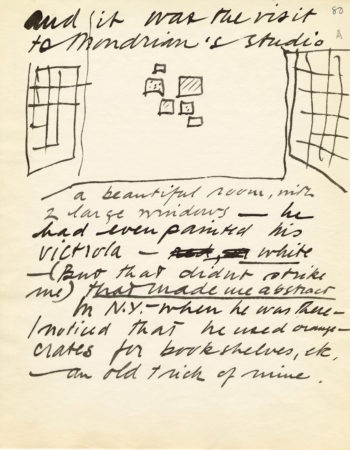
Calder exhibits nine works, including Le Lanceur de poids and Acrobate, at the “Association Artistique les Surindépendants,” Parc des Expositions, Porte de Versailles, Paris.
CF, exhibition fileThérèse Bonney photographs Calder in his studio at 7 Villa Brune.
NYPL, photography collection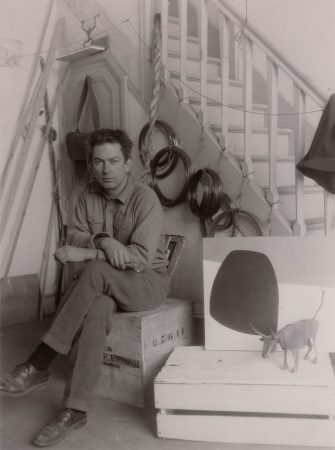
Calder exhibits jewelry at the Mansard Gallery, London.
CF, Calder to Thomson, 5 NovemberLouisa James decides to marry Calder. I have just come home from a polo game with a not particularly entrancing young man, and I have decided that I am sick to death of going out with one person and another that don’t interest me. I am sick of it chiefly because the only
person that amuses me and has amused me for the last year and a half, is Sandy. The only thing to do to my mind is to make it permanent and get married, and the sooner the better . . . To me Sandy is a real person which seems to be a rare thing. He appreciates and enjoys the things in life that most people haven’t the sense to notice. He has ideals, ambition, and plenty of common sense, with great ability. He has tremendous originality, imagination, and humor which appeal to me very much and which make life colorful and worthwhile. He enjoys working and works hard, and thus ends the summary of his character.
Calder makes a gold ring to present to Louisa James. I had known a little jeweler in Paris, Bucci, and he had helped me make a gold ring—forerunner of an array of family jewelry—with a spiral on top and a helix for the finger. I thought this would do for a wedding ring. But Louisa
merely called this one her “engagement ring” and we had to go to Waltham, near by, and purchase a wedding ring for two dollars.
Calder exhibits four wood sculptures, including Cow, in “Painting and Sculpture by Living Americans” at the Museum of Modern Art, New York.
CF, exhibition fileCalder returns to New York on the Bremen.
Calder 1966, 114; AAA, postcard, Wiser to Calder1931
Calder prints postcards to announce performances of Cirque Calder at 903 Seventh Avenue, New York. Five performances are given; each audience includes about thirty spectators.
AAA, circus announcement; The World, 18 JanuaryCalder performs Cirque Calder at the James’s home in Concord, Massachusetts.
Calder 1966, 115Calder and Louisa James are married. The reverend who married us apologized for having missed the circus the night before. So I said: “But you are here for the circus, today.”
Calder 1966, 115
The Calders sail for Europe on the American Farmer. They return to live in Calder’s studio at 7 Villa Brune.
Hayes 1977, 249–50; Calder 1966, 116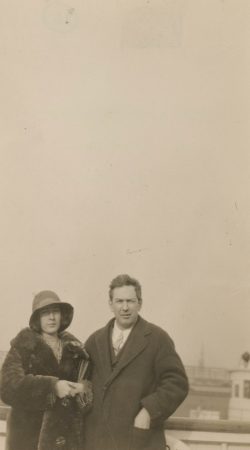
The Abstraction-Création group is founded; members include Jean Arp, Robert Delaunay, William “Binks” Einstein, Jean Hélion, Mondrian, and Anton Pevsner.
Calder 1966, 114Calder begins to incorporate movement into abstract objects. I felt that perhaps I was exactly a perfectionist: i.e. that who was I to decide that a thing should be just this way, or just that way—so I made one or 2 objects articulated, so that they could be in a number of
positions.
Calder’s abstract work is presented for the first time in the exhibition “Alexandre Calder: Volumes–Vecteurs–Densités / Dessins–Portraits,” at Galerie Percier, Paris. Léger writes in the introduction to the catalogue:
Eric Satie illustrated by
CALDER
Why not?
“It’s serious without seeming to be.”
Neoplastician from the start, he believed in the absolute of two colored rectangles. . . .
His need for fantasy broke the connection; he started to “play” with his materials: wood, plaster, iron, wire, especiallly iron wire. . . .a time both picturesque and spirited. . . .
. . . .A reaction; the wire stretches, becomes rigid, geometrical—pure plastic—it is the present era—an anti-Romantic impulse dominated by the problem of equilibrium.
Looking at these new works—transparent, objective, exact—I think of Satie, Mondrian, Marcel Duchamp, Brancusi, Arp—those unchallenged masters of unexpressed and silent beauty. Calder is of the same line.
He is 100% American.
Satie and Duchamp are 100% French.
And yet, we meet?
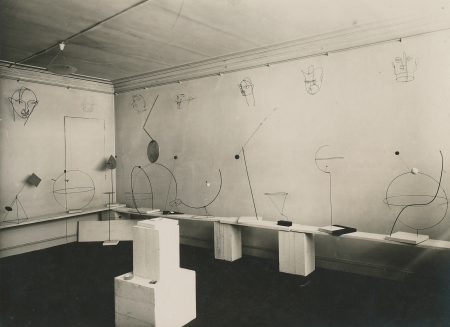
Pablo Picasso arrives before the opening at Galerie Percier to preview the exhibition privately. He introduces himself to Calder.
CF, Calder 1955–56, 95The Calders move into a three-story house at 14 rue de la Colonie. Calder makes the top floor of his house his studio.
Calder 1966, 121; Hayes 1977, 252–53; AAA, taxi receipt
Calder reinstalls the Galerie Percier exhibition in his home at 14 rue de la Colonie. I am going to set the show up again, more or less as it was in the galerie.
CF, Calder to Winston, 16 MayMary Reynolds is up from Villefranche for a few weeks, so we are seeing a bit of her and Marcel Duchamp.
CF, Calder to parents, c. 5 JuneLouisa buys a dog, a small Briard mix. She and Calder name him Feathers because of his wispy hair.
Calder 1966, 121–22; CF, Calder to parents, c. 16 June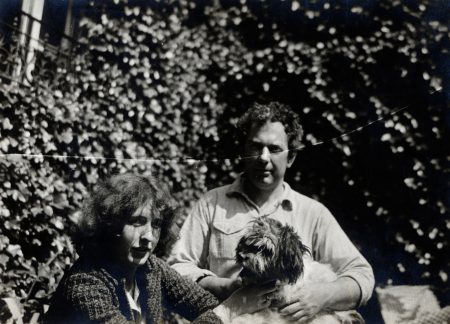
Calder accepts an invitation to join Abstraction-Création.
Calder 1966, 114; CF, Calder to parents, 1 JulyCalder performs Cirque Calder in his studio at 14 rue de la Colonie.
CF, project fileCalder’s wire sculpture is included in an exhibition of Novembergruppe at Künstlerhaus, Berlin.
CF, exhibition fileCalder writes his parents of his new work: I have been making a few new abstractions which have certain movements combined with their other features. I think there is something in it that may be good.
CF, Calder to parents, 12 JulyThe Calders visit Palma de Mallorca, staying at the Hotel Mediterraneo. They call on the Juncosas, Pilar Miró’s family. After a month in Paguera, they return to Paris.
CF, Calder to parents, 31 July, 18 September; Calder 1966, 122–23Harrison of Paris publishes Fables of Aesop, According to Sir Roger L’Estrange, containing fifty illustrations by Calder.
CF, project fileCalder exhibits four sculptures in “Association Artistique les Surindépendants” at Parc des Expositions, Porte de Versailles, Paris.
CF, exhibition fileCalder performs Cirque Calder in his studio at 14 rue de la Colonie.
FJM, Calder to Miró, 1931Using cranks and small electric motors, Calder concentrates on making mechanized abstract sculptures.
Calder 1966, 126Marcel Duchamp visits the studio at 14 rue de la Colonie again and sees Calder’s latest works. There was one motor-driven thing, with three elements. The thing had just been painted and was not quite dry yet. Marcel said, “Do you mind?” When he put his hands
on it, the object seemed to please him, so he arranged for me to show in Marie Cuttoli’s Galerie Vignon, close to the Madeleine. I asked him what sort of a name I could give these things and he at once produced “Mobile.” In addition to something that moves, in French it also means motive. Duchamp also suggested that on my invitation card I make a drawing of the motor-driven object and print: CALDER/SES MOBILES.
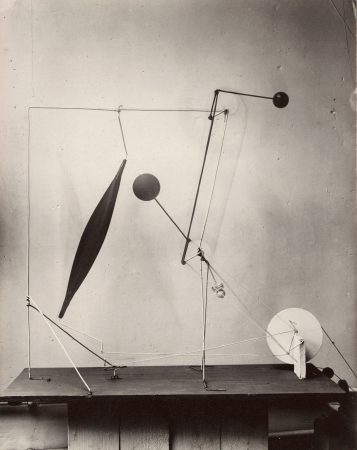
Calder selects a sculpture from among the works exhibited at Galerie Percier and donates it to the recently founded Miejskie Muzeum Historji i Sztuki (Muzeum Sztuki w Lodzi), in Lodz, Poland. The work is later lost during World War II. (Calder 1966, 118)
Calder 1966, 118Calder exhibits with Abstraction-Création at Porte de Versailles, Paris, and performs Cirque Calder.
CF, Calder to parents, 1 July; Lipman 1976, 331The Calders visit Port-Blanc in the Côtes-du-Nord, Brittany.
Calder 1966, 125–26; CF, Louisa to mother, 30 November1932
Calder publishes “Comment réaliser l’art?” for the first issue of Abstraction-Création, Art Non Figuratif.
Out of volumes, motion, spaces bounded by the great space, the universe.
Out of different masses, light, heavy, middling—indicated by
variations of size or color—directional line—vectors which represent speeds, velocities, accelerations, forces, etc. . . .—these directions making between them meaningful angles, and senses, together defining one big conclusion or many.
Spaces, volumes, suggested by the smallest means in contrast to their mass, or even including them, juxtaposed, pierced by vectors, crossed by speeds.
Nothing at all of this is fixed.
Each element able to move, to stir, to oscillate, to come and go in its relationships with the other elements in its universe.
It must not be just a “fleeting” moment, but a physical bond between the varying events in life.
Not extractions,
But abstractions
Abstractions that are like nothing in life except in their manner of reacting.
Calder exhibits drawings, including Untitled, in “Exposition de Dessins” at Galerie Vignon, Paris.
CF, exhibition fileCalder exhibits two works, including Untitled, in “‘1940′” at Parc des Expositions, Porte de Versailles, Paris.
CF, exhibition fileCalder makes Cadre rouge, among the first in a series of “frames” and “panels” that consist of moving abstract forms set in front of colored plywood panels or within boxlike frames. The works relate to the idea of three-dimensional paintings in motion that Calder proposed to Mondrian during his 1930 visit.
Sweeney 1951, 38; CF, object files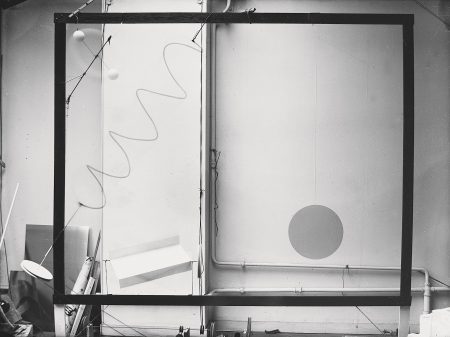
Calder exhibits in the Fifth Annual Exhibition of Modern French Painting at the Renaissance Society at the University of Chicago.
CF, exhibition file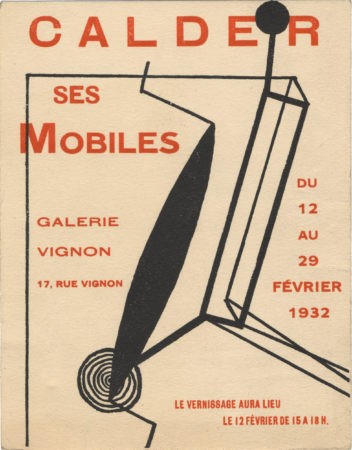
In response to Duchamp’s term “mobile,” Arp asks sarcastically, Well, what were those things you did last year [for Percier’s]—stabiles? Calder adopts “stabile” to refer to his static works.
Calder 1966, 130Calder performs Cirque Calder in his studio at 14 rue de la Colonie.
AAA, circus posterCalder writes the statement “Que ça bouge: À propos des sculptures mobiles.”
The various objects of the universe may be constant, at times, but their reciprocal relationships always vary.
There are environments that appear to remain fixed whilst
there are small occurrences that take place at great speed across them. They appear so only because one sees nothing but the mobility of the small occurrences.
We notice the movement of automobiles and beings in the street, but we do not notice that the earth turns. We believe that automobiles go at a great speed on a fixed ground; yet the speed of the earth’s rotation at the equator is 40,000 km every 24 hours.
As truly serious art must follow the greater laws, and not only appearances, I try to put all the elements in motion in my mobile sculptures.
It is a matter of harmonizing these movements, thus arriving at a new possibility of beauty.
In a letter to Kiesler, Calder describes the reaction to his mobiles. We had a lot of visitors—Léger, Picasso, Carl Einstein, Binks Einstein, Petro van Doesburg, Cocteau, Roux, etc.—who all were enthusiastic about “abstract sculptures which move” (toy elec. motors being
used). There was only one dissenter . . . that was Mondrian. He said they weren’t fast enough, and when I stepped on the gas, he said they still weren’t fast enough, so I said I’d make one especially fast, to please him, and then he said that that wouldn’t be fast enough—because the whole thing ought to be still. Now I feel that beauty of motion is a very real thing—unrelated to any definite machinery. Whether I’ve achieved it is, of course, another question.
Joan Miró, the Spanish painter who lives now in Barcelona, is in Monte Carlo, doing the decors for a Ballet Russe. He knows my stuff, so I wrote him, and sent him photos and perhaps I will be able to arrange for myself to do a ballet next year. The Russian who used to do them, Daglieff (?)
[sic], died 2 years ago, but one of the McCormacks has put up some money for their continuance.
In preparation for their departure from Antwerp to New York on a Belgian freighter, the Calders rent their house to Gabrielle Buffet, the former wife of Francis Picabia.
Calder 1966, 136–37Calder introduces himself in writing to American art critic James Johnson Sweeney. About 3 or 4 months [ago] M. Fernand Léger came to my house in Paris to see my “mobiles”—abstract sculptures which move—and said he would like to bring you to have a look at them too . . . I am
exposing a few of these “mobiles” at the Julien Levy Gallery 602 Madison Ave N.Y.C. and would be very pleased if you would come and see them.
“Calder: Mobiles / Abstract Sculptures” is held at the Julien Levy Gallery, New York. The exhibition announcement reprints Léger’s introduction to Calder’s 1931 Galerie Percier catalogue.
CF, exhibition file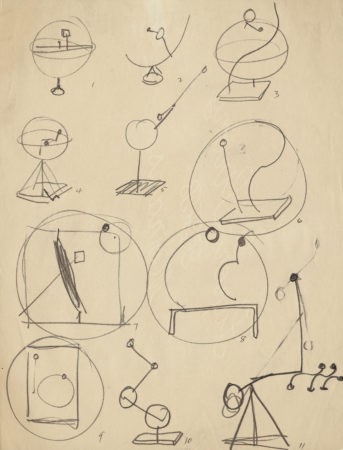
Before a group of reporters visiting his exhibition at Julien Levy Gallery, Calder demonstrates the motion in Two Spheres. This has no utility and no meaning. It is simply beautiful. It has a great emotional effect if you understand it. Of course if it meant anything it
would be easier to understand, but it would not be worthwhile.
The Calders visit Louisa’s parents in Concord. Calder performs Cirque Calder at the James’ home.
CF, Calder 1955–56, 146; Concord Herald, 16 JuneWhile visiting Calder’s parents in Richmond, Massachusetts, Calder performs Cirque Calder in an old barn that Stirling uses as a studio. Invitees include Nitze, Drew, and Josephy.
CF, Calder to Nitze, 11 July; CF, Calder 1955–56, 146The Calders arrive in Barcelona after a fourteen-day passage on the Cabo Tortosa, Garcia and Díaz Spanish line. Following a stop in Málaga, they take a train from Barcelona to Tarragona.
Calder 1966, 138–40; FJM, Calder to Miró, 19 JulyThe Calders arrive at the Miró farm in Montroig for an eight- to ten-day visit. During their stay, Calder performs Cirque Calder for the Mirós, their farmhands, and their neighbors. Miró recalls the event: He came to Montroig and brought the circus figures; he never stopped working on
them. We organized a presentation for the local farmers who were very pleased with the spectacle of the wire performers. Later the Cirque was presented in galleries, but there in Montroig it was really a performance for the people.
The Calders and Mirós visit Cambrils and Tarragona.
Calder 1966, 139The Calders return to Barcelona and visit Gaudí’s basilica. Invited by the Amics de l’Art Nou, Calder performs Cirque Calder in the hall of the Grup d’Arquitects i Tecnics Catalans per al Progres de l’Arquitectura Contemporania (GATCPAC). Shortly thereafter, the Calders return to Paris.
Calder 1966, 140–41; Gasch 1932Calder performs Cirque Calder in his studio at 14 rue de la Colonie.
CF, Calder to Picasso, 10 NovemberCalder performs Cirque Calder in his studio at 14 rue de la Colonie.
CF, Calder to Picasso, 10 November1933
Calder publishes “Un Mobile” for the second issue of Abstraction-Création, Art Non Figuratif.
A “Mobile.”
Dimensions: 2 meters by 2 meters 50.
Frame: 8 centimeters, neutral red.
The 2 white balls turn very rapidly.
The black helix turns less rapidly and seems to always climb.
The iron plate turns still less quickly, the two black lines seeming always to climb.
The black pendulum, 40 centimeters in diameter, climbs by 45° on each side, passing in front of the frame, at the rate of 25 turns a minute
Calder’s sculptures are included in the group exhibition “Première série,” organized by the Association Artistique Abstraction-Création, Paris.
CF, exhibition fileThe Calders take a train from Paris to Madrid, where they visit the Museo del Prado.
CF, Calder to Peggy, 2 February
Works by Calder are presented at the Sociedad de Cursos y Conferencias, Residencia de Estudiantes de la Universidad de Madrid. Calder also performs Cirque Calder for the students.
AAA, circus program; CF, Louisa to mother, 11 FebruaryCalder performs Cirque Calder in Barcelona.
CF, Louisa to mother, 11 FebruaryMiró arranges for an exhibition of drawings and sculpture by Calder at the Galería Syra, Barcelona.
CF, Louisa to mother, December 1932, 11 February
